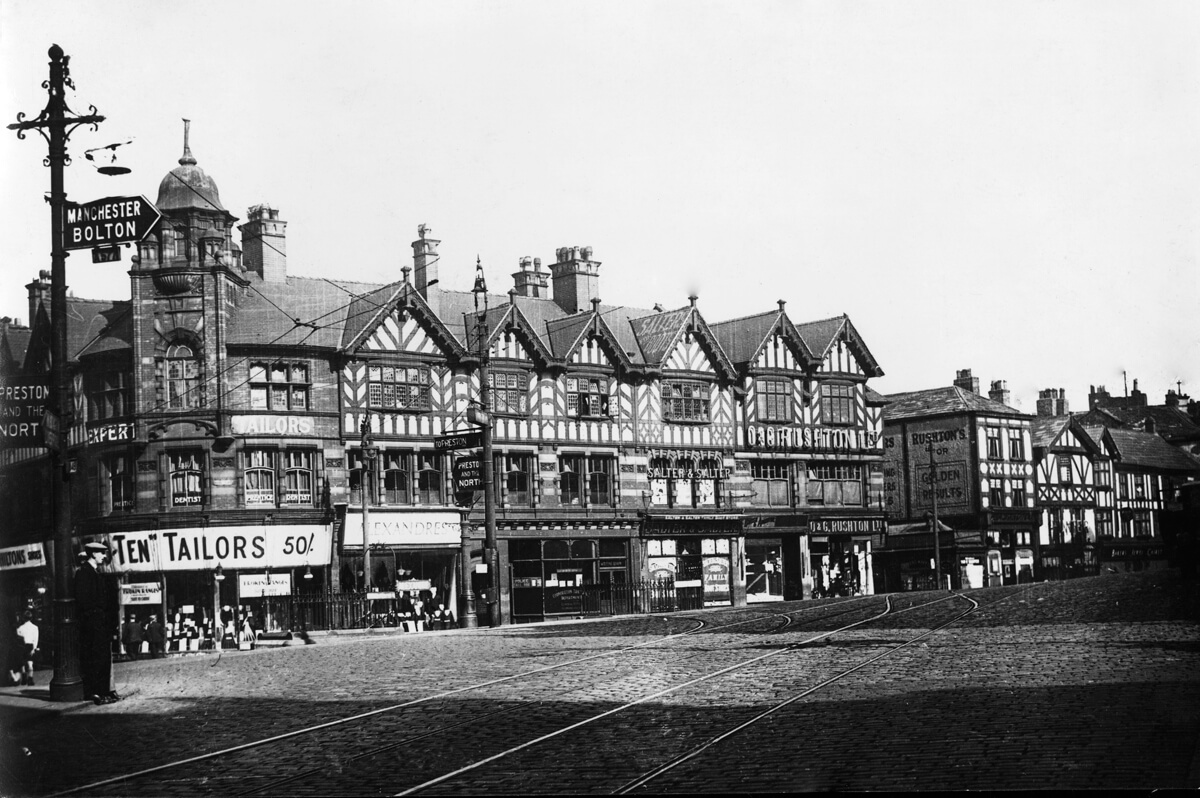
Rita Culshaw has wonderful memories from her time as a ‘pit brew’ lass and says she never went hungry as a child
We meet the people of Wigan who say Orwell made their town a byword for grotesque poverty, by Ros Wynne-Jones and Claire Donnelly

“I started work at Wigan Junction Colliery in 1948 the Monday after my 15th birthday,” Rita Culshaw says, her eyes resting on the pair of battered but beloved clogs on the table in front of us.
“I was only a little thing, 4ft 10 and about five stone, but I was strong enough.
“My sister took me at 6am. We walked two miles from home. I still remember the sparks my clogs made when I walked on the cobbles. We went and got changed at the new baths – you put your shawl and an old man’s jacket on with your clogs and in you went. They used to put Vaseline on your eyelashes to stop the coal dust sticking.”
From 1948 to 1951, Rita was a “pit brew” lass, one of the young girls whose small hands were nimble enough to sort coal from dirt as it ran along a conveyor belt at the “brew” – the brow of the pit.
“People write about it like it were a nightmare – George Orwell did,” Rita, now an 83-year-old grandmother, says. “But it weren’t like that. They were the best years of my life.”
Memories of Wigan: Slag heaps like mountains, smoke, rows of blackened houses, sticky mud criss-crossed by imprints of clogs, heavy-set young women standing at street corners with their babies wrapped in their shawls, immense piles of broken chocolate in cut-price confectioners’ windows.
Orwell’s diary entry for Wigan, The Road to Wigan Pier
We’ve come to see Rita as we retrace Orwell’s steps, recreating his famous Road to Wigan Pier on the 80th anniversary of the journey he made with his typewriter. Orwell’s journey doesn’t actually end in Wigan. But because of its title, the book unwittingly made the town a byword for grotesque poverty.
At a commemorative event at the Sunshine House community centre close to the tripe shop where he lodged, one woman gets up to say she’d set up a Facebook group to discuss the book locally.
“I can’t repeat any of it here,” she said. “It just became an argument about what part of people’s anatomy they’d wipe the book on.”
Wiganers resent the fact the Old Etonian chose to stay at the Brookers’ tripe shop when more sanitary lodgings were available.
Tony Hammond, the son of charismatic union leader Jim Hammond, who showed the writer around Wigan, says his dad “never forgave Orwell for the way he felt he’d shown the worst housing, hadn’t shown the way a lot of people lived”.

Now 81, Tony is a living example of post-war social mobility, the blacklisted miner’s son who became a high court judge.
“My dad always worried I would sell out,” he says. “I don’t think I ever did.”
Louise Fazackerley, an award-winning Wigan poet, says: “Mrs Brooker is basically on the sick. It’s like Benefits Street choosing families to show the worst of people.”
The writer himself admitted that “for some reason, though it’s not worse than 50 other places, Wigan has always been picked on as a symbol of the ugliness of the industrial areas”. Yet his book’s title cemented the town’s reputation.
As a modern-day correction, Fazackerley takes us to the beautifully restored Mesnes Park and for a tour of the new arts centre where she works, the Old Courts.
“Unlike Orwell, I grew up never believing writing could possibly be a job,” she says. “This place is about challenging that.”
In Wigan various people gave me their opinion that it is best to get shut of your teeth as early in life as possible. 'Teeth is just a misery,' one woman said to me. In one house where I stayed there were, apart from myself, five people, the oldest 43 and the youngest a boy of 15. Of these the boy was the only one who possessed a single tooth of his own and his teeth were obviously not going to last long.
Orwell on Wigan, The Road to Wigan Pier
She laughs about the ‘pier’ in Orwell’s title, a tumbledown wooden coal jetty on the canal that survived only as a music-hall joke, even in his day.
“I think Orwell was trying to speak up for common people – but as a town we have suffered the full stigma of that famous book,” she says.
Perhaps that’s why in the town Orwell’s visit is damned with faint commemoration – a plaque on a grass verge where the tripe shop used to stand.

Rita says she believes that for 80 years the book has made the town want to distance itself from its proud coal-mining past. Now the local history group, Wigan Heritage and Mining Monument, is raising funds for a statue of the miners and “pit brew” lasses.
“Wiganers’ sweat helped power the Industrial Revolution and make Britain one of the richest countries in the world,” Rita says. “It’s time we remembered that.”
Across the town there is the sense that Wigan is starting a new chapter. The formerly industrial part of the Leeds-Liverpool Canal is now earmarked as the Wigan Pier Quarter. Wigan North Western will be the North West’s gateway to the high-speed rail network HS2.
The town’s Labour MP, Lisa Nandy, talks of how the future of Britain lies with places like Wigan that once “powered this country with mines and steelworks” where “tightly knit communities and a strong sense of identity and shared history offer a vision for the future far preferable to faceless globalisation”.
Rita and others say despite the book’s legacy, Orwell did get many things right. “His descriptions of mining are very accurate,” says Rita, who is reading The Road to Wigan Pier on her Kindle. “But look at us now, with foodbanks. I think it’s actually worse. I never, ever, went hungry as a child.”
A community that battled to build a new future after the end of Lancashire coalfields now faces the onslaught of austerity cuts and insecure work. And where in Orwell’s day Wiganers struggled to gain help from the Public Assistance Committee and suffered the indignity of the Means Test, today the town is battling the rollout of Universal Credit.
Some 80% of people changing to the new benefit in the town have been plunged into rent arrears.
Meanwhile, a shocking 500 Wiganers reported themselves homeless in the past year and a fifth of children live in poverty.

The dialect term Rita uses for hunger – “fur klempt” – is today the name of a local scheme using surplus supermarket food to make nutritious meals for people on low incomes.
During our time in Wigan’s foodbanks, homeless shelters, lunch clubs, community projects and estates, we find plenty of evidence of deep poverty – but also a resilience missing from Orwell’s book.
The most famous woman in The Road to Wigan Pier is an image seen by Orwell from a train window of a “slum girl poking a stick up a foul drainpipe”. That image might have been Rita or her mother, yet her memories are of a strong community that held each other up.
“I can honestly say I’d go back tomorrow,” Rita says. “They’re on about opening a new mine up and I’ve told them, ‘Put me down for the pit brew’.”
Rita was only the second child in her area born in a council house after early slum clearances. Even in this comparative luxury, she shared a bed with her five siblings, with overcoats for blankets.
Yet her memories are alive with dancing on Sundays and the pig saved to feed guests at her 21st birthday party at which she wore a yellow cardigan with pearl buttons.
“My dad was a pitman,” Rita says. “My mum worked in the cotton factory but she’d empty the coal wagons as well.”
In the early morning the mill girls, clumping down the cobbled street, all in clogs, make a curiously formidable sound, like an army hurrying into battle. I suppose this is the typical sound of Lancashire. And the typical imprint in the mud of a clog-iron, like one half of a cow’s hoof.
Orwell’s diary entry for Wigan, The Road to Wigan Pier
No talking was allowed so Rita and the other women learned to lip-read and, because she was the youngest, she also had to fetch the miners’ lunch. “I got paid one shilling and ten a week,” she says.
In the library where Orwell sat and wrote, now the Museum of Wigan Life, you can see where he signed out reference books as E A Blair, his real name – Eric Arthur Blair – and 72 Warrington Lane for his lodgings above the tripe shop.
“Mr Orwell,” he wrote, “liked Wigan very much – the people, not the scenery.”
And perhaps the town has something to thank Orwell for, after all. As well as the sting of stigma, his book has helped the town develop an almost unparalleled sense of northern working-class resilience, defiance and identity – all vital as it starts to negotiate the road forward from Wigan Pier.
What the numbers say

Your story

If you live in any of the places mentioned in the Wigan Pier Project and have a story to share, please get in touch.
You can contact us via wiganpier2017@mirror.co.uk tweet us at @WiganPier80 or write to Wigan Pier Project, Daily Mirror, One Canada Square, Canary Wharf, London E14 5AP
From the archives
Fascinating photographs from the Mirror archives showing what Wigan looked like when Orwell visited
















 For housing advice
For housing advice

 For general advice
For general advice

 For foodbank help
For foodbank help

 For help in work or out of work
For help in work or out of work



